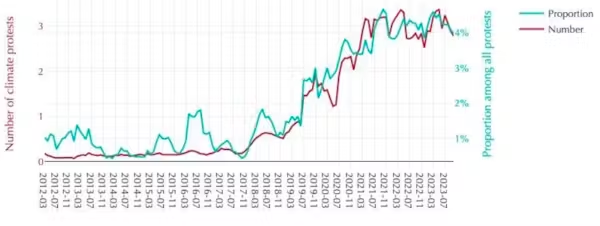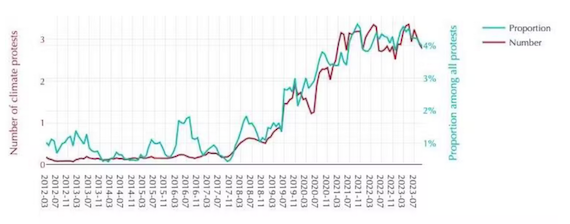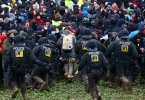Across the globe, a growing wave of climate and environmental activism is being met with an increasingly forceful response. Governments, law enforcement agencies, and corporate interests are intensifying efforts to suppress protests that challenge destructive environmental practices and demand urgent climate action.
From Europe to South America, and Asia to North America, peaceful demonstrators are facing surveillance, intimidation, legal crackdowns, and even violence. Laws are being restructured to criminalize dissent, while activists are labeled as threats rather than changemakers.
This rising repression not only undermines democratic freedoms but also delays the urgent transitions needed to combat climate change. As the climate crisis deepens, the right to protest and speak out is becoming one of its most endangered casualties.
Read More: Global Crackdown on Climate and Environmental Protests Intensifies
Four Ways Activism is Being Repressed Globally
The intensifying criminalisation and repression of climate and environmental activism is manifesting in four primary ways. These tactics undermine democratic freedoms and obstruct urgent climate action.
Introduction of Anti-Protest Laws
Many governments have enacted anti-protest legislation that expands police powers to restrict demonstrations.
These laws may criminalize peaceful protests by introducing new offenses, extending sentence lengths, or granting legal impunity to authorities when protesters are harmed. In the 14 countries studied, researchers identified 22 new such laws introduced since 2019 alone, reflecting a clear trend toward suppressing dissent through legal means.
Criminalisation of Protest Through Legal Prosecution
Activists increasingly face prosecution under laws originally designed for combating terrorism or organized crime. For example, in May 2024, members of the German direct-action group Letzte Generation were charged with “forming a criminal organisation”—a legal designation typically reserved for mafia groups.
Similarly, in the Philippines, anti-terrorism legislation has been weaponized against environmental defenders, restricting their movement and legal rights.Other tactics include lowering thresholds for prosecution, barring climate-related defenses in court, and issuing injunctions that allow corporations to legally block protests against them.
These legal pressures significantly raise the risks activists face.
Escalation of Policing Measures
Repression also takes the form of harsher policing strategies such as surveillance, arrests, violent dispersals, infiltration, and intimidation. Both state actors—like police and military forces—and private entities, including corporate security and organized crime, participate in these efforts.
For instance, German regional police have been accused of cooperating with an energy corporation and its private fire brigade to evict coal mine protesters. Similarly, private security forces have been heavily involved in suppressing anti-mining protests in Peru, demonstrating the collaboration between corporate interests and law enforcement.
Killings and Enforced Disappearances
In the most extreme cases, environmental activists face targeted killings and disappearances. According to data from the NGO Global Witness, these violent acts have become alarmingly common in countries such as Brazil, the Philippines, Peru, and India.
Organized crime groups often perpetrate murders in Brazil, while in Peru, the police have been implicated.These deadly actions represent the gravest form of repression, silencing voices that challenge powerful interests.
Rising Tide of Protests and Repression
To understand the broader context, data from the Armed Conflict Location & Event Data Project (ACLED) reveals a significant rise in climate protests since 2018-2019. On average, climate-related demonstrations constitute about 4% of all protests in the 81 countries analyzed from 2012 to 2023.Environmental protests have also increased steadily in the 14 countries examined.

Despite this growth in activism, repression remains widespread: approximately 3% of climate and environmental protests involve police violence, and 6.3% result in arrests.The extent of repression varies by country. Activist groups like Extinction Rebellion in Australia and the UK often engage in actions that invite arrest, contributing to arrest rates as high as 20% and 17%, respectively.

Canada tops the list with 27% of climate protests involving arrests. Police violence is particularly notable in Peru (6.5%) and Uganda (4.4%), while France experiences relatively high police violence (3.2%) paired with lower arrest rates.
Frequent Asked Question (FAQs)
What forms does repression of climate and environmental protests take?
Repression primarily occurs through four main tactics: introduction of anti-protest laws, criminalisation of protest via prosecutions, harsher policing tactics (including surveillance and violence), and in extreme cases, killings or disappearances of activists.
How are anti-protest laws used against activists?
These laws often expand police powers to prevent protests, create new criminal offenses for demonstrators, increase penalties, and sometimes grant immunity to authorities who harm protesters. Since 2019, dozens of such laws have been introduced globally.
Can peaceful climate protests be treated as criminal acts?
Yes. In some countries, laws designed for terrorism or organized crime are being applied to non-violent activists, leading to serious charges like “forming a criminal organisation.” This legal strategy aims to intimidate and silence activists.
What kinds of policing tactics are used to suppress protests?
Authorities and private security forces use stop-and-search procedures, arrests, violence, surveillance, infiltration of activist groups, and intimidation to control and deter protests.
Are activists at risk of violence beyond policing?
Tragically, yes. In some countries, environmental activists face threats of violence, disappearances, and even murder, often perpetrated by organized crime or, in some cases, state actors.
Is climate activism increasing despite repression?
Yes. Data shows that climate and environmental protests have risen sharply since 2018 and continue to grow worldwide, even as repression intensifies.
Conclusion
The global crackdown on climate and environmental protests highlights a troubling trend where states and powerful interests increasingly prioritize suppression over dialogue. Through legal barriers, criminal prosecutions, aggressive policing, and, in some cases, violence and murder, activists face escalating risks simply for demanding urgent action on the climate crisis.






